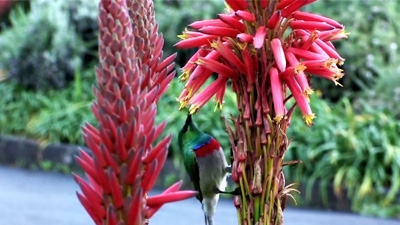“The African continent is undergoing a fundamental transformation,” says Jamal Saghir, World Bank Director for Sustainable Development in the Africa Region. “We see biodiversity as an essential component of inclusive green growth, and are committed to strengthening our role as a leading supporter of African countries' conservation efforts.”
Managing landscapes, not just protected areas
Landscape-level planning and management extends biodiversity conservation beyond protected areas, which can ever only cover a limited area. This approach integrates biodiversity considerations into agriculture and designates ecological corridors that build upon existing social and institutional arrangements.
In South Africa’s Cape Region – which boasts some of the highest plant diversity levels in the world – the government, with support from the World Bank, worked with farmers and municipalities to increase by 282 percent the area of highly threatened lowland ecosystems under conservation.
“Protected areas play an important role in biodiversity conservation,” says Magda Lovei, World Bank Africa Region Sector Manager for Environment, Natural Resources, Water, and Disaster Risk Management. “The new landscape-level approaches described here complement the protected area approach, and in fact help expand the reach of protection efforts.”
Addressing organized crime
The decimation of species due to a recent dramatic increase in poaching has made headlines: Cameroon’s Bouba-Ndijida National Park, for example, lost 300 to 500 of Cameroon’s remaining 1,000 to 5,000 elephants between January and March of this year alone. South Africa is projected to lose 500 to 600 rhinoceroses this year, when as recently as 2007 that number was only 13. Organized criminal networks are responsible for much of the slaughter.
Among the fixes for this grave threat, three stand out: Increasing local law enforcement to stem the hemorrhage of species; increasing successful prosecution to ensure that crime doesn’t pay; and increasing cooperation between countries and across sectors to track trade routes and shut down smuggling rings.
“We really need more attention on environmental law enforcement to solve poaching. Over the long-term, this approach can cut the cost of conservation and contribute to getting at the root of the poaching epidemic,” says Lead Natural Resource Economist William Magrath.
Innovative Governance Model
Conservation funding needs to be structured for the long term, not only to address problems like poaching but to ensure that countries have predictable resources to manage their biodiversity. This will require mobilizing new funds and cutting the cost of conservation. New instruments, such as green bonds, will be key to this. The integration of conservation into projects such as tourism, infrastructure, climate change adaptation, and disaster risk management provides an avenue for conservationists to tap a broader array of financial resources.
Partnerships
Budgetary constraints are also one reason why an increasing focus is being accorded to partnerships with the private sector. In Zambia’s Kafue National Park, World Bank support to the park authorities led to private investors tripling available accommodations, such that tourism visits rose markedly and park revenues grew ten-fold within six years. Similarly, in South Africa’s Greater Addo Elephant National Park, a $5.5 million investment spurred $14.5 million in private sector investment and the creation of 614 jobs. In both cases, partnerships with businesses helped to improve conservation outcomes.
As threats to biodiversity grow, conservationists will increasingly have to turn to innovative strategies and sources of financing such as these.

